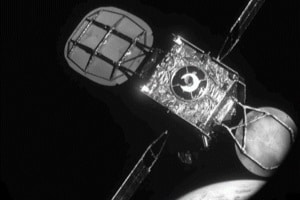MEV-1: A Look Back at Intelsat’s Groundbreaking Journey
On April 2, 2020, Intelsat 901 (IS-901) returned to service after docking with Northrop Grumman’s Mission Extension Vehicle (MEV-1) in geostationary orbit. Intelsat celebrated IS-901’s mission-extension milestone almost 55 years to the day after the historic launch of Intelsat 1 (a.k.a. “Early Bird”), the world’s first communications satellite, which brought us momentous events like the moon landing, “live via satellite.”

Unlike Early Bird, IS-901’s pioneering moment came 19 years after its launch. One of 53 satellites in Intelsat’s world-leading fleet, IS-901 has long provided broadcast, direct-to-home, managed and VSAT services to dozens of Intelsat’s commercial and government customers. To preserve an uninterrupted service experience for those customers and others, Intelsat explored – and ultimately chose to invest in – in-orbit servicing technology to extend the satellite’s life.
Innovative firsts are not for the faint of heart. With a track record of pushing the boundaries of what’s possible and turning possibilities into reality, Intelsat was up to the mission.
Come along with us as we recap the nearly nine-month journey of IS-901 and Northrop Grumman’s first-ever Mission Extension Vehicle (MEV-1), and what lies ahead.
Why Did We Do It?
We pride ourselves in being proactive to ensure our valued customers receive the best possible service experience.
Ultimately, mission-extension services represent a smart and efficient way to maintain our existing fleet, preserve our customers uninterrupted experience and free up even more resources to invest in advanced, next-generation technologies.
How Was it Done?

In early December 2019, Intelsat began to raise IS-901’s orbit to the same altitude as MEV-1 in preparation for docking, the most critical part of the mission.
The docking’s maneuvers required precise synchronicity between Intelsat’s and Northrop Grumman’s operations teams. Multiple cameras, laser range finders and on-board computers allowed MEV-1 to detect, track and rendezvous with IS-901. The two spacecraft completed the historic docking on February 25 at 2:15 a.m. ET.
Back in Service!
After the docking, the combined spacecraft stack, now steered by MEV-1, spent several weeks relocating to its intended geosynchronous orbital slot.
On April 2, Intelsat’s operations staff returned IS-901 to service, seamlessly transitioning around 30 commercial and government customers onto the satellite. The transition took approximately six hours and was conducted by many Intelsat operations staff working remotely, due to COVID-19.
What’s Next?

When IS-901 has reached the end of its life, MEV-1 will again raise the combined vehicle stack to high geostationary altitude and then detach IS-901 to rest in graveyard orbit. MEV-1 will then be able to service another satellite.
We predict MEV and in-orbit servicing technology will continue to serve as a valuable and cost-effective tool we use to repair and extend the life of our otherwise healthy, high-performing satellites to best serve our customers’ needs.
Imagine the possibilities of in-orbit servicing and the types of missions these satellite-preserving vehicles may be capable of managing in the near future. One thing’s for sure … Intelsat will remain at the forefront of accelerating these transformative technologies.






















